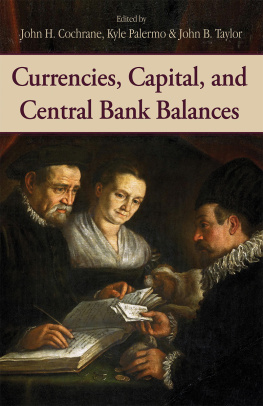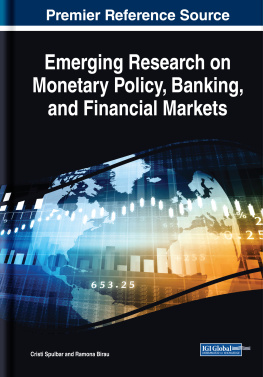PREFACE
The Depository Institutions Deregulation and Monetary Control Act of 1980 is the most comprehensive attempt at financial and monetary reform since the 1930s. It is only the first step in a series of reforms that will be required to restructure and improve the financial system and monetary control. The act addresses a number of significant issues, but, just as importantly, it fails to deal with others. Despite its weaknesses, the legislation represents a major step toward developing a more viable, competitive, and flexible financial system that can meet the credit and liquidity needs of a growing economy.
The first draft of this study was written during the spring and summer of 1980 while we, the authors, were visiting scholars in the Division of Banking Research and Economic Analysis at the Office of the Comptroller of the Currency. We had the unusual opportunity of being in Washington and of being closely associated with many issues relating to the act. The study draws on that experience to develop the background for understanding why the act was passed and what its likely effects will be during the remainder of the 1980s. Assessing the act's effects posed major difficulties, given that, at the time of writing, only slightly more than one year had elapsed since its passage. Much will change in the next few years, and much depends on new legislative efforts to further pursue the act's objectives. The Reagan administration will in all likelihood continue to move the financial system toward a more competitive orientation and the monetary system toward more effective control.
We would especially like to thank the following individuals, who commented on the manuscript during its several draft stages: Robert Barone, John Bilson, Robert Hall, Susan Krause, Thomas Mayer, Thomas Moore, David Pyle, and Steven Weiss. We especially appreciate the comments provided by Milton Friedman and other participants in the monthly seminar of the Federal Reserve Bank of San Francisco and at seminars held at the University of California at Berkeley, the University of Nevada at Reno, the University of Oregon, and the Western Economic Association meetings, where the study's results were presented.
We benefited greatly from experience gained at the Office of the Comptroller of the Currency. We were able to attend and participate in agency seminars, conferences, policy briefings, and interagency decision-making committees. In particular, we would like to thank John Heimann, Cantwell Muckenfuss III, William Longbrake, Neal Soss, Jonathan Fiechter, and Harold Nathan at the comptroller's office for their help and encouragement. Nevertheless, the views expressed are the authors and in no way represent those of the Office of the Comptroller.
Some of this material is based upon work supported by the National Science Foundation under Grant No. SPI-7914816. Any opinions, findings, and conclusions or recommendations expressed in this publication are those of the authors and do not necessarily reflect the views of the National Science Foundation.
We also thank Peter Berman, George Kaufman, Ralph Kimball, Thomas Kilcollin, James Pierce, Thomas Simpson, Robert Weintraub, and the fellows of the Hoover Institution for their help in interpreting the events and their background. Of course, none of the persons mentioned is accountable for any errors or misinterpretations that may remain in the text.
Finally, we appreciate the encouragement of Phyllis Cairns, David Fleenor, and Helen Tartar, and we thank three students at Stanford University: Elizabeth Baccelli for her happy and competent assistance in conducting the research, and Julaporn Bhaedhayacheep and Bill Andersen for checking parts of the work. Ilse Dignam, Consuelo Garcia, Arnita Thurston, and Gloria Watson diligently typed the manuscript in its various stages.
1. ISSUES IN FINANCIAL REFORM AND MONETARY CONTROL: LATE 1979 AND EARLY 1980
Society requires three features in its financial system. First, the system should provide an efficient flow of funds between lenders and borrowers. Second, it is relied upon to maintain a reasonable degree of soundness among financial institutions and markets during adverse economic events. Third, it needs to be adaptable to changes in the economic environment. The financial system in the United States has not always met these requirements and has periodically malfunctioned.
Two themes occur throughout the history of financial reform in the United States. Such reform is both crisis oriented and concerned with enhancing the soundness of the financial system. Legislative change governing the institutional infrastructure of financial transactions has occurred in response either to collapse or to serious disruption of the flow of funds from lenders to borrowers. In response to the crisis, reform has been directed toward improving the soundness of the financial system. The literature does not clearly define soundness in the present context, and various commentators use the term in different ways. In this discussion, a sound financial system is taken to mean that institutions and markets maintain an efficient flow of funds even in the presence of adverse economic events. The failure of individual institutions, though not on the scale of the banking collapse of the early 1930s, is compatible with a sound financial system.
The wide range of legislative change introduced in the 1930s illustrates the orientation of financial reform toward both crisis and soundness. The unprecedented collapse of the banking system and the inability of the Federal Reserve to effectively counteract it led to passage of the Banking Acts of 1933 and 1935, the Securities Act of 1933, and the Securities Exchange Act of 1934. Not since the passage of the National Banking Act of 1863 had so much financial reform been enacted in such a short period of time. That legislation sought to establish a sound financial system by imposing constraints on the competitive behavior of banks, increasing federal regulation of both banks and nonbank financial institutions, and augmenting the powers of the Federal Reserve System.
FINANCIAL REFORM
The financial structure until very recently reflected the reforms introduced during the 1930s and it satisfied, albeit imperfectly, the basic functions of a financial system until the mid-1960s. At that time, the system was exhibiting signs of incompatibility with the economic environment, and increasing concern was expressed about the viability of financial institutions (









